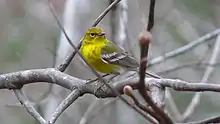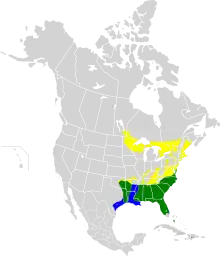Pine warbler
The pine warbler (Setophaga pinus) is a small songbird of the New World warbler family.
| Pine warbler | |
|---|---|
 | |
| Adult male | |
| Scientific classification | |
| Domain: | Eukaryota |
| Kingdom: | Animalia |
| Phylum: | Chordata |
| Clade: | Dinosauria |
| Class: | Aves |
| Order: | Passeriformes |
| Family: | Parulidae |
| Genus: | Setophaga |
| Species: | S. pinus |
| Binomial name | |
| Setophaga pinus (Linnaeus, 1766) | |
 | |
| Range of S. pinus (note: missing range on Hispaniola) Breeding range Year-round range Wintering range | |
| Synonyms | |
| |
Description
These birds have white bellies, two white wing bars, dark legs and thin, relatively long pointed bills; they have yellowish 'spectacles' around their eyes. Adult males have olive upperparts and bright yellow throats and breasts; females and immatures display upperparts which are olive-brown. Their throats and breasts are paler. The adult male pine warbler looks somewhat similar to the yellow-throated vireo which may cause some identification problems.
| Standard Measurements[2][3] | |
|---|---|
| Length | 5–5.75 in (127–146 mm) |
| Weight | 12 g (0.42 oz) |
| Wingspan | 8.75 in (222 mm) |
| Wing | 68.9–72.8 mm (2.71–2.87 in) |
| Tail | 52.9–56 mm (2.08–2.20 in) |
| Culmen | 9.9–11.6 mm (0.39–0.46 in) |
| Tarsus | 17.2–18.7 mm (0.68–0.74 in) |
The song of this bird is a musical trill. Their calls are slurred chips.
Distribution and habitat

Their breeding habitats are open pine woods in eastern North America. These birds are permanent residents in southern Florida. Some of them, however, migrate to northeastern Mexico and islands in Bermuda and the Caribbean. The first record for South America was a vagrant wintering female seen at Vista Nieve, Colombia, on 20 November 2002; this bird was foraging as part of a mixed-species feeding flock that also included wintering Blackburnian and Tennessee warblers.[4]
Behavior
They forage slowly on tree trunks and branches by poking their bill into pine cones. These birds also find food by searching for it on the ground. These birds mainly eat insects, seeds and berries.
Their nests are deep, open cups, which are placed near the end of a tree branch. Pine warblers prefer to nest in pine trees, hence their names. Three to five blotched white eggs are laid.[2]
References
- BirdLife International (2016). "Setophaga pinus". IUCN Red List of Threatened Species. 2016: e.T22721719A94725481. doi:10.2305/IUCN.UK.2016-3.RLTS.T22721719A94725481.en. Retrieved 11 November 2021.
- Godfrey, W. Earl (1966). The Birds of Canada. Ottawa: National Museum of Canada. p. 338.
- Sibley, David Allen (2000). The Sibley Guide to Birds. New York: Knopf. p. 442. ISBN 0-679-45122-6.
- Strewe, Ralf; Navarro, Cristobal (2004). "New and noteworthy records of birds from the Sierra Nevada de Santa Marta region, north-eastern Colombia" (PDF). Bulletin of the British Ornithologists' Club. 124 (1): 38–51. Archived from the original (PDF) on 2005-12-31. Retrieved 2020-03-17.
External links
- "Pine warbler media". Internet Bird Collection.
- Pine warbler - Dendroica pinus - USGS Patuxent Bird Identification InfoCenter
- Pine warbler species account - Cornell Lab of Ornithology
- Pine warbler bird sound at Florida Museum of Natural History
- BirdLife species factsheet for Dendroica pinus
- Pine warbler photo gallery at VIREO (Drexel University)
- Audio recordings of Pine warbler on Xeno-canto.
